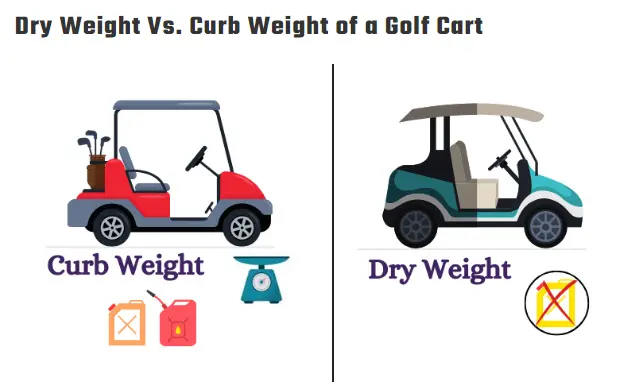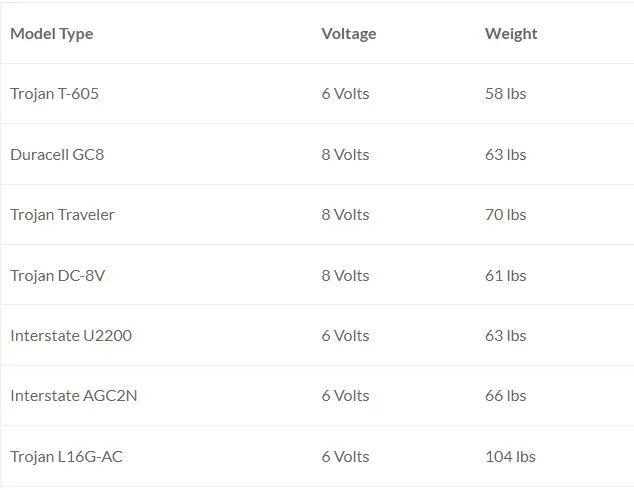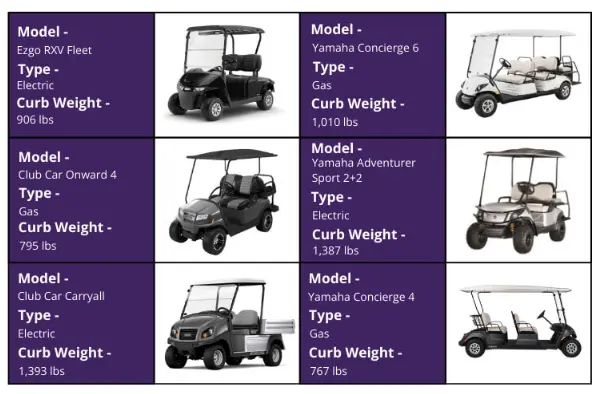How Much Does a Golf Cart Weigh?

A golf cart is a small vehicle primarily designed to transport golfers and their equipment around a golf course. It is electric or gas-powered and typically has room for two passengers and their golf bags.
Golf carts are known for their compact size, ease of maneuverability on grass, and relatively low speeds, making them ideal for navigating the terrain of a golf course.
In recent years, golf carts have also found applications beyond golf courses, such as retirement communities, industrial facilities, and significant events where short-distance transportation is needed.
Background Of Golf Cart
The golf cart was invented in the early 1950s by Merle Williams, president of the Marketeer Company in California, USA. Williams originally designed the electric golf cart for use on golf courses, aiming to provide a convenient means of transportation for golfers and their equipment.
The first golf carts were electric-powered and resembled today’s modern designs in basic form. Since then, golf carts have evolved significantly in design, features, and applications beyond golf courses.
Know About The Golf Cart Dimensions and Weight
Golf carts come in various sizes and weights depending on their purpose and design. Here are some general dimensions and weights typically seen in golf carts:

1. Dimensions:
- Length: Typically ranges from 6 to 8 feet (1.8 to 2.4 meters). This measurement helps determine how much space it occupies and its stability.
- Width: Usually between 3 to 4 feet (0.9 to 1.2 meters). This measurement is essential for maneuverability on golf courses and in other settings where golf carts are used.
- Height: Generally around 5 to 6 feet (1.5 to 1.8 meters), including most models’ roofs.
2. Weight:
Electric Golf Carts usually weigh between 500 and 1,000 pounds (227 to 454 kilograms) without batteries. Batteries, depending on the type and capacity, can weigh between 800 and 1,300 pounds (363 to 590 kilograms).
Gas-powered golf Carts Tend to be heavier, typically ranging from 900 to 1,200 pounds (408 to 544 kilograms), again depending on the specific model and features.
These dimensions and weights can vary depending on the golf cart’s manufacturer, model, and intended use. Variations, such as two-seater or four-seater configurations, can also affect dimensions and weight slightly.
What is the Width of a Golf Buggy
As mentioned earlier, the width of a golf buggy (or golf cart) is generally between 3 to 4 feet (0.9 to 1.2 meters). This width allows easy navigation on paths and around obstacles typically found on golf courses.
Golf carts or buggies are designed to be compact yet sturdy vehicles suitable for efficiently transporting golfers and their gear around a golf course or similar environments. Their dimensions and weight are optimized for maneuverability, comfort, and functionality in such settings.
Golf Cart Measurements included:
The measurements of a golf cart typically include
- Length
- Width
- Height.
Examples of Different Golf Cart Weights:
- 2-passenger Club Car Villager:
- Electric (48-volt): 975 lbs
- Gas: 675 lbs
- Lifted 4-passenger Club Car Carryall:
- Electric (48-volt): 1125 lbs
- Gas: 875 lbs
- 6-passenger Club Car Precedent Stretch PTV:
- Electric (HP): 1293 lbs
- Gas: 980 lbs
Dry Weight and Curb Weight: Understanding the Basic Structure
Dry weight refers to the weight of the golf cart without any fluids (like fuel or oil), passengers, or additional accessories.
It represents the fundamental weight of the golf cart’s chassis and main components before any operational fluids or extras are added.
Knowing the dry weight helps manufacturers, dealers, and users understand the cart’s base weight for transportation, storage, and initial performance assessments.
Curb weight is the total weight of the golf cart when it is fully equipped with all standard equipment, fluids (such as fuel or oil), and a complete set of batteries (if applicable).
This measurement reflects the golf cart’s actual operational weight under typical conditions, including everything needed for normal operation.
Curb weight is crucial for determining the maximum payload capacity (the weight it can carry in addition to its weight), assessing stability, and ensuring compliance with weight-related regulations and standards.
Also Read: Home Hyper Tech
Effect of Golf Cart With Dry and Curb Weight
The dry weight and curb weight of a golf cart are two critical specifications that can affect its performance and usage:

- Dry Weight: This refers to the weight of the golf cart without any passengers or cargo. It typically includes the basic structure, chassis, batteries (if electric), and other essential components. The dry weight is vital for understanding the cart’s base weight and can influence factors such as maneuverability, acceleration, and energy efficiency.
- Curb Weight: This includes the dry weight of the golf cart plus any additional items or accessories that may be installed or loaded onto the cart, such as seats, canopies, golf bags, and passengers. The curb weight gives a more realistic measure of the golf cart’s weight in actual use conditions.
Effects on Performance:
- Acceleration and Speed: The lighter the golf cart (lower dry weight), the better its acceleration and potential top speed, especially if it’s electric and relies on battery power.
- Energy Efficiency: A lighter golf cart generally requires less energy to operate, which can extend battery life in electric models or reduce fuel consumption in gas-powered carts.
- Handling and Maneuverability: Lighter carts tend to be more agile and maneuverable, which can be advantageous in tight spaces or uneven terrain.
- Load Capacity: Curb weight directly affects how much additional weight the cart can carry without exceeding its design limits. Heavier curb weights may reduce the available payload capacity for passengers and cargo.
Practical Considerations:
- Usage: Understanding the weight specifications helps choose a golf cart suitable for its intended use—whether for golfing, recreational purposes, or utility tasks.
- Battery Life: Electric carts with lower weights typically have longer battery life per charge due to reduced energy demands.
- Maintenance: Heavier carts may require more robust components and maintenance, while lighter carts might have lower maintenance needs.
These weights can significantly impact a golf cart’s performance, efficiency, and handling characteristics.
Impact of Battery Weight on Golf Carts
- Battery Weight Considerations
- Despite appearances, golf cart batteries typically weigh between 50 and 80 pounds.
- This weight can exceed your bags, clubs, and other gear combined!
- Performance Implications
- Extra battery weight can affect maneuverability, especially on inclines.
- Consider routes carefully to manage heavier carts safely.
- Battery Types and Weights
- Golf carts use 6-volt, 8-volt, or 12-volt batteries.
- Battery weight varies significantly; for instance, a 6-volt Trojan L16G-AC weighs 104 lbs, whereas an 8-volt Duracell GC8 weighs 63 lbs.
- Voltage vs. Weight
- Higher voltage does not necessarily mean heavier batteries.
- Voltage indicates electrical potential, not size or weight.
- Choosing the Right Cart
- Calculate the impact of battery weight on your golfing experience.
- Ensure your cart’s weight suits your needs for both performance and safety.
Weight Does A Golf Cart Battery Weigh

Impact of Engine Type With Towing Capacity – Golf Cart Performance
The towing capacity of a golf cart, around 1,000 pounds on average, varies based on engine type, terrain, and cart weight. This capability proves handy, even for occasional golf outings, ensuring readiness for assisting others or transporting equipment to diverse locations like lakeside areas.
When considering golf carts, the type of engine or power source significantly influences their performance and characteristics:
- Electric Engines:
- Quiet operation with minimal maintenance.
- Instant torque for quick acceleration.
- It requires charging and has a limited range per charge.
- Gasoline Engines:
- More extended range and quicker refueling compared to electric carts.
- Generally more potent for uphill climbs and heavy loads.
- Requires regular maintenance and fueling.
- Diesel Engines:
- It is less common in golf carts but offers high torque and fuel efficiency.
- Suitable for heavy-duty use and extended operation periods.
- Requires regular diesel fuel and maintenance.
- Performance Considerations:
- Engine type affects handling, acceleration, and noise levels.
- Choose based on your needs for range, power, and operational convenience.
- Consider environmental impact and operational costs in your decision-making process.
Understanding these engine types helps you select a golf cart that best suits your intended use, whether for golfing, utility, or recreational purposes.
Golf Cart Dimensions Parking – Factors To Know
When considering the dimensions required for parking a golf cart, it’s essential to account for the space the cart occupies and the maneuverability needed to park and access it comfortably. Here are some general guidelines:
- Space Requirements:
- Length: A typical golf cart ranges from 6 to 8 feet (1.8 to 2.4 meters). Therefore, you would need a parking space that accommodates this length without obstruction.
- Width: A golf cart’s width is usually 3 to 4 feet (0.9 to 1.2 meters). This width ensures the cart can fit comfortably within the parking space without cramping.
- Height: The height, including any roof structure, typically ranges from 5 to 6 feet (1.5 to 1.8 meters). If the golf cart has a roof or any attachments that increase its height, ensure that there is overhead clearance.
- Maneuverability:
- Consider the turning radius and clearance space required to maneuver the golf cart into and out of the parking space. Adequate space around the parking area allows easy access and avoids damage to the cart or surrounding objects.
- Accessibility:
- Ensure enough space around the golf cart parking area for passengers to embark and disembark comfortably. This includes space for opening doors if applicable, particularly in multi-passenger carts.
- Surface:
- Golf carts are often parked on grass, gravel, or paved surfaces. Ensure the parking area is level and stable to prevent the cart from rolling or sinking.
- Consider Local Regulations:
- In some areas, specific regulations may govern where and how golf carts can be parked. Comply with local rules or guidelines to avoid fines or penalties.
What About Gas vs. Electric?
When comparing gas-powered and electric golf carts:
- Weight Considerations:
- Electric carts can be heavier due to battery weight, adding up to 400 pounds depending on the number and type of batteries.
- Gas-powered carts typically weigh less overall compared to battery-powered carts, which can vary significantly in weight depending on their configuration.
- Battery Impact:
- The number and weight of batteries installed influences the weight of electric carts.
- Gas-powered carts generally have a lighter base weight because they do not carry heavy batteries.
- Overall Variation:
- The specific weight difference between gas and electric carts depends on individual cart models and configurations.
- Gas-powered carts tend to be lighter, offering a potential advantage in certain conditions and applications.
What Is the Weight Of An E-Z-GO Golf Cart?
The weight of an E-Z-GO golf cart typically ranges from 700 to 1,250 lbs. This variation is influenced by factors such as the specific model of the cart and whether it is powered by gas or batteries. Gas-powered models generally weigh less than their battery-powered counterparts due to the additional weight of batteries in electric carts.
Also Visit:
- How To Tow a Golf Cart?
- HOW TO CLEAN A GOLF CART WINDSHIELD
- HOW TO USE BALSAMIC VINEGAR FOR WEIGHT LOSS?
- HOW MUCH DOES A SNOWBOARD COST?
- HOW TO TEST A GOLF CART SOLENOID
Golf Cart Weight By Brand

FAQ
How Much Does a Golf Cart Battery Weigh?
– Average weight: 110 lbs
How Much Does a Club Car Golf Cart Weigh?
– Average weight: 90 lbs
How Much Does a 48 Volt Golf Cart Weigh?
– Average weight: 70 lbs
How Much Does a Gas Golf Cart Weigh?
– Average weight: 70 lbs
How Much Does an Electric Golf Cart Weigh?
– Average weight: 50 lbs
How Much Does a Golf Cart Weigh (Club Car)?
– Average weight: 50 lbs
How Much Does a 4-Seater Golf Cart Weigh?
– Average weight: 40 lbs
How Much Does a Yamaha Golf Cart Weigh?
– Average weight: 30 lbs
How Much Does a 12 Volt Golf Cart Battery Weigh?
– Average weight: 20 lbs
How Much Does a 36 Volt EZGO Golf Cart Weigh?
– Average weight: 20 lbs
How Much Does a 36 Volt Golf Cart Weigh?
– Average weight: 20 lbs

I am a content writer and affiliate marketer with a passion for crafting engaging and informative content that drives traffic and sales. With years of experience in the industry, I have honed my skills in SEO, social media marketing, and email marketing to help businesses reach their target audience and achieve their goals.
